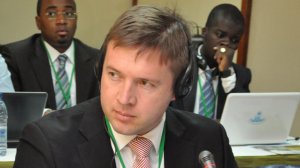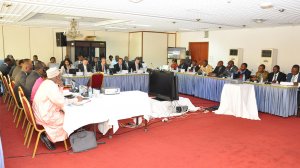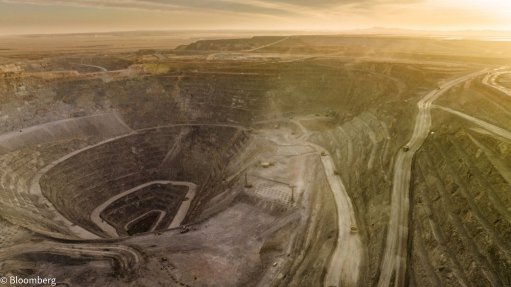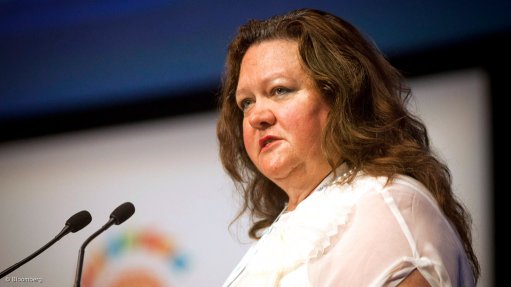A$40m investment secured for Africa iron-ore project



ANDREW VAN ZYL The Mbalam-Nabeba iron-ore project is unique and something in which very few countries have experience
HIGH-LEVEL NEGOTIATIONS The Cameroon government entered into the Mbalam Convention, in November 2012, following negotiations with all the relevant stakeholders
ASX-listed iron-ore developer Sundance Resources announced in September that it had received A$40-million from Ukrainian-born resource investor Gennadiy Bogolyubov’s investment holding company Wafin, to progress Sundance’s Mbalam-Nabeba iron-ore project, which straddles the borders of Cameroon and the Republic of Congo.
The project involves the development of a 35-million-tonne-a-year deep-water minerals terminal facility, in Cameroon. Iron-ore deposits in Cameroon and the Congo will supply this facility for an estimated 35 years.
The project will also entail the construction of a 510 km rail line from the Mbarga mine, in Cameroon, and a 70 km rail spur line connecting the Nabeba mine, in Congo, to the minerals terminal. Construction of the project is expected to start in 2016.
Construction company Mota-Engil Africa has been appointed as the engineering, procurement and construction management contractor for the $3.5-billion port and rail infrastructure project.
Meanwhile, Sundance Resources and the government of Cameroon signed railway and minerals terminal concessions for the Mbalam-Nabeba project in June.
In November 2012, the Cameroon government entered into the Mbalam Convention, which required that a number of additional conditions be met, including the signing of the railway and minerals terminal concessions.
The Mbalam Convention is the overarching document and is the basis of the agreement for the project. It also provides a framework for all other agreements and serves as a guiding principle for negotiations for any future developments during the life of the project.
The agreements regulate the rights and obligations of Sundance and government regarding the construction and operation of key infrastructure assets servicing the Mbalam and Nabeba mines. They also detail the procedure for the eventual transfer of these assets to the Cameroon government.
The agreements further outlined third-party access to infrastructure, a framework for expanding the infrastructure once built, and the mechanism to easily facilitate future changes to the legal ownership of the infrastructure.
Mine consultancy SRK Consulting partner Andrew van Zyl, who has been acting as a technical adviser to the Cameroon government since the start of the project, notes that privately owned rail, port and mining projects of this scale are rare.
“It is a unique project and something in which very few countries have experience. Examples of those that do are Australia and Brazil, however, these countries have established regulatory regimes, which are more developed than Cameroon’s as a result of many years of engagement between companies and government agencies. Projects in these jurisdictions also usually involve major mining companies with large balance sheets simplifying financing.”
Van Zyl adds that the project will be challenging because of the need to develop appropriate regulatory and legal frameworks to protect the interests of government and facilitate a project of unprecedented scale and complexity.
He notes that, previously, Cameroon’s legislation did not need to accommodate a project of this nature. Therefore, government needed to develop an approach to the project that would meet the interests of all stakeholders.
“You have a company that is making a huge investment on which it requires a reasonable return and yet you have an asset that is also of long-term strategic and national significance, of which the State will become the custodian. The State, therefore, needs to determine how it is going to balance that requirement with its mandate to not interfere in Sundance’s operation to the extent that investors will be concerned,” says Van Zyl.
He adds that a significant achievement of the government team has been to avoid the creation of a private monopoly over the infrastructure but grant government the discretion to facilitate future projects that are in the interests of the nation.
“But, simultaneously, Sundance is reassured that the government of Cameroon will maintain the financial and operational integrity of the system that Sundance will put in place,” concludes Van Zyl.
Comments
Press Office
Announcements
What's On
Subscribe to improve your user experience...
Option 1 (equivalent of R125 a month):
Receive a weekly copy of Creamer Media's Engineering News & Mining Weekly magazine
(print copy for those in South Africa and e-magazine for those outside of South Africa)
Receive daily email newsletters
Access to full search results
Access archive of magazine back copies
Access to Projects in Progress
Access to ONE Research Report of your choice in PDF format
Option 2 (equivalent of R375 a month):
All benefits from Option 1
PLUS
Access to Creamer Media's Research Channel Africa for ALL Research Reports, in PDF format, on various industrial and mining sectors
including Electricity; Water; Energy Transition; Hydrogen; Roads, Rail and Ports; Coal; Gold; Platinum; Battery Metals; etc.
Already a subscriber?
Forgotten your password?
Receive weekly copy of Creamer Media's Engineering News & Mining Weekly magazine (print copy for those in South Africa and e-magazine for those outside of South Africa)
➕
Recieve daily email newsletters
➕
Access to full search results
➕
Access archive of magazine back copies
➕
Access to Projects in Progress
➕
Access to ONE Research Report of your choice in PDF format
RESEARCH CHANNEL AFRICA
R4500 (equivalent of R375 a month)
SUBSCRIBEAll benefits from Option 1
➕
Access to Creamer Media's Research Channel Africa for ALL Research Reports on various industrial and mining sectors, in PDF format, including on:
Electricity
➕
Water
➕
Energy Transition
➕
Hydrogen
➕
Roads, Rail and Ports
➕
Coal
➕
Gold
➕
Platinum
➕
Battery Metals
➕
etc.
Receive all benefits from Option 1 or Option 2 delivered to numerous people at your company
➕
Multiple User names and Passwords for simultaneous log-ins
➕
Intranet integration access to all in your organisation




















